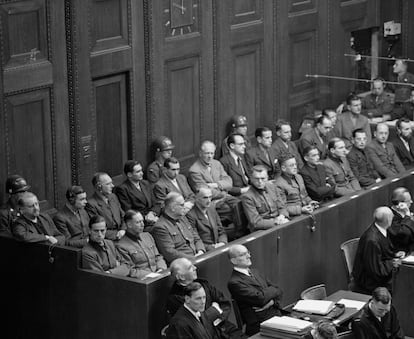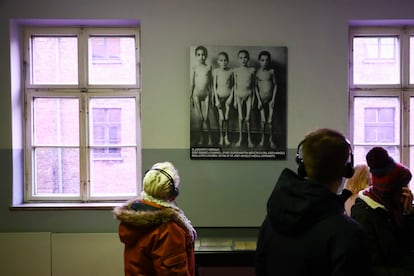Beyond the Angel of Death: The medical establishment’s role in Nazi horror
A report in the ‘The Lancet’ shows how nationalist ideology corrupted the most advanced science and medicine of its time

Anita Andres was less than two years old when she was admitted to an institution for children with developmental disabilities in Mosbach, Germany. The little girl had not reached her cognitive and physical developmental milestones. It was 1941, and the Nazi regime had years earlier approved the sterilization of people with disabilities or, in the case of pregnancy, abortion. But for children with a cognitive disorder or physical disability, a ministerial order was issued in 1939. Along with 52 other children, Anita was referred to the Psychiatric University Hospital in Heidelberg. It was directed by Carl Schneider, one of the leading psychiatrists of his time. He led a study that sought to establish the differences between congenital developmental disabilities and those acquired in the first months and years of life. Schneider was also behind the state euthanasia program, Aktion T4. After being used as part of the study, Anita was murdered like 10,000 other children with disabilities. The Lancet medical journal has just published a report, entitled Studying medicine, Nazism, and the Holocaust crucial to strengthening medical education and ethics today, full of stories like Anita’s. Published 90 years after Hitler’s rise to power, one of its aims is to provide a comprehensive overview of the research and to ensure that current and future medical professionals do not forget the horrific application of medical science and practice at that time.
Medicine during the Nazi period is probably famous today because of experiments carried out by people like Josef Mengele, the so-called Angel of Death, on the prisoners of the Auschwitz extermination camp. First assigned to the Roma camp, Mengele ended up as head of the Auschwitz-Birkenau complex infirmary. His power over who died and who lived a little longer, was absolute. At the foot of the ramps of the trains that brought Jews like cattle from all over Europe, Mengele would point left or right, deciding who went directly to the showers, i.e., the gas chambers, and who was assigned to forced labor. His infamous research on twins was especially chilling.
However, sinister characters like Mengele or Schneider obscure the real drama. Professor Herwig Czech of the Medical University of Vienna, co-chair of the report’s commission, says “it is often surprising how little is known about the medical crimes of the Nazis, beyond perhaps a vague idea of Josef Mengele’s experiments at Auschwitz.” In fact, the situation was far worse and went way beyond the participation of just a few doctors. The introduction to the report reads: “Perhaps the most pernicious fallacy about medical involvement in Nazism and the Holocaust is the notion that medical atrocities were the acts of individual, radicalized physicians.”
This idea of it having involved just a few bad apples is contradicted by the data flagged up in the report: among the liberal professions, it was doctors who were the most affiliated with the NSDAP, the National Socialist German Workers’ Party. As many as 65% of German doctors were members by the end of the war, the report cites. Many probably signed up out of simple opportunism, but it explained the authoritarian thinking of the majority of doctors and their personal conviction that Jews contaminated the German people.

Another of the myths that the report attempts to explode is the view that what was applied was not German science, but a kind of pseudoscience that was favored by the Nazis. This is possibly due, at least in part, to the medical community’s desire to distance itself and its research from those who committed the crimes. However, as the report points out, much of the research conducted during the Nazi regime was published in scientific journals, the usual route for validating results. Some of the findings were read and applied all over the world over many decades and have ended up integrated into general medical knowledge, often without any links to their obscure origin.
During the Nuremberg trials, in which Nazi leaders and their accomplices, including prominent physicians, were put on trial, a series of altitude and hypothermia experiments, conducted by Dachau camp physician Sigmund Rascher, came to light. Although the tests were almost always fatal for those participating, U.S. aviation had no qualms about exploiting their results. Moreover, as The Lancet report notes, several of the scientists involved in this research, such as Siegfried Ruff and Hubertus Strughold, were recruited immediately after the war by the U.S. Army Air Force. Strughold had a distinguished career in the U.S. space program, being considered the father of space medicine. Even the fact that some of the diseases and conditions identified bore the names of the Nazi physicians who sent their patients to their deaths, such as Asperger’s syndrome or Reiter’s syndrome, is not generally known.
The report insists it is not out to demonize German medicine as there were other cases of complicity with the authorities in committing genocide. But the German case is special as it is the best documented horror story, despite bids to eliminate evidence when the war came to a close. More importantly, according to the The Lancet Commission, German science was at the pinnacle of European science which itself represented the pinnacle of human progress. For example, bioethics was born in Germany: in 1900, when a series of syphilis experiments on women and children caused a scandal, human experimentation became regulated, which was decades before any other country thought to do so. In other cases, the Nazi regime and its doctors merely copied what was being done elsewhere: the first forced sterilization laws were passed in Switzerland and Denmark five years before Hitler came to power. And the 1933 German law stipulating the sterilization of people with disabilities was inspired by an American senator. In the U.S., thousands of Latino women were sterilized in the first half of the 20th century and the disabled continued to be sterilized until the 1970s.
Out of the Nazi horror and the subsequent Nuremberg trials, the first international standards emerged on the treatment of patients and, in particular, the establishment of informed consent for human trials. Commission Co-Chair Dr. Sabine Hildebrandt of Boston Children’s Hospital and Harvard Medical School comments: “Our report sets out some of the most horrific distortions of medical practice and policies in history, and it is incumbent on all in the health and medical community to keep the memory of the events of the Nazi era from fading. We must study this history of the worst of humanity, to recognize and work against similar patterns in the present, with the goal of promoting the best.”
Sign up for our weekly newsletter to get more English-language news coverage from EL PAÍS USA Edition
Tu suscripción se está usando en otro dispositivo
¿Quieres añadir otro usuario a tu suscripción?
Si continúas leyendo en este dispositivo, no se podrá leer en el otro.
FlechaTu suscripción se está usando en otro dispositivo y solo puedes acceder a EL PAÍS desde un dispositivo a la vez.
Si quieres compartir tu cuenta, cambia tu suscripción a la modalidad Premium, así podrás añadir otro usuario. Cada uno accederá con su propia cuenta de email, lo que os permitirá personalizar vuestra experiencia en EL PAÍS.
¿Tienes una suscripción de empresa? Accede aquí para contratar más cuentas.
En el caso de no saber quién está usando tu cuenta, te recomendamos cambiar tu contraseña aquí.
Si decides continuar compartiendo tu cuenta, este mensaje se mostrará en tu dispositivo y en el de la otra persona que está usando tu cuenta de forma indefinida, afectando a tu experiencia de lectura. Puedes consultar aquí los términos y condiciones de la suscripción digital.
More information
Archived In
Últimas noticias
Most viewed
- Sinaloa Cartel war is taking its toll on Los Chapitos
- Oona Chaplin: ‘I told James Cameron that I was living in a treehouse and starting a permaculture project with a friend’
- Reinhard Genzel, Nobel laureate in physics: ‘One-minute videos will never give you the truth’
- Why the price of coffee has skyrocketed: from Brazilian plantations to specialty coffee houses
- Silver prices are going crazy: This is what’s fueling the rally











































